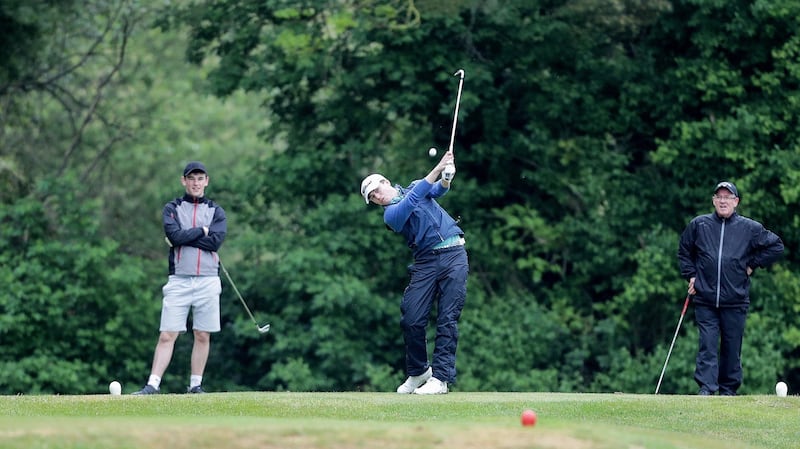The numbers don’t lie. Over the last year in Ireland more people have been playing golf than perhaps ever before. Membership rates in clubs around the country saw huge boosts last year with many courses increasing their numbers by over 100 members while Golf Ireland report about a 10 per cent increase in membership across the board for the year 2020.
Just this week the R&A, along with Golf Ireland, released a study which shows that the number of people playing golf across Ireland over the last year increased by 219,000 to 540,000. Significantly the average age of golfers across Britain and Ireland fell by five years to 41 with the majority of people playing golf now aged under 55.
Timesheets throughout last summer were filling up the moment they opened and, despite being closed for a total of 209 days at various stages between March 2020 and April 2021, many golf courses still exceeded their average annual number of rounds.
The longest single closure of all faced by golf clubs over the last 14 months – between December 31st and April 26th – could be looked at in two ways by clubs in that, one the one hand, the first few months of the year are generally the quietest for courses but, on the other, they're also the months that clubs are looking for subscription renewals from their members.
While retention rates were lower than hoped over the first couple of months, most clubs spoken to by The Irish Times report a sharp jump in the number of members renewing from March onwards and, in particular, when the Government announced that golf could reopen on April 26th. Some clubs which had seen retention rates of only around 50 or 60 per cent throughout January and February of this year were quickly reaching levels of over 90 per cent with the number of applications from new members also rising.
Carr Golf manage and maintain a number of golf clubs around the country including the likes of Castleknock, Elmgreen, Corballis and Seapoint and, as chief revenue officer Alex Saul puts it: “some golf clubs did well but ultimately the winds of 2020 in a golfing perspective were felt in participation, they weren’t felt in profit.”
Now the question for golf in Ireland is how to ensure that those increased participation rates remain high and new golfers don’t fall away from the game when life gets back to normal and there are more social and sporting outlets available to people.

One area clubs are focusing on is doing more for members. A major change in golf over the last number of years is the dwindling number of members who only play a few times during the summer and the uptick in members who want to play once a week at minimum.
That means courses are busier and members are getting more value for their subscription fee but it also means more competition for space on the timesheet. Last year most clubs with large membership numbers were seeing timesheets for weekend competitions fill up within minutes of opening, leading many to limit the number of rounds members were permitted to play each week.
This year most busy member clubs are offering more of the timesheet to members and cutting back on time given to societies and green fees despite the fact that both of those avenues create important revenue. Whereas before clubs may have sectioned off, for example, 75 per cent of the timesheet for members and the other 25 for green fees and societies, many are now operating on the basis of closer to 90 per cent for member tee times.
“I think it is about prioritising and increasing member access and engaging with the members to say: what are the elements of the last year that you’ve enjoyed?” says Saul. “Is it more spaced out tee times? Is it some of the more informal aspects of socialisation that have been brought in? We’ve seen it around some of our clubhouses where the clubs really enjoy the outdoor barbecues and the more informal stuff that now happens at the back of the 18th green.
“A lot of members who have come in over the last 12 months didn’t necessarily have any history in the game so they’re coming in, they’re high handicappers and whilst we’re welcoming them the reality is that they’re not really made feel welcome. The older member who is an eight-handicapper and is playing in the group behind wants to barge through them. So I think we have to find a way to welcome high handicappers into the game.
“If I go down to my local GAA club or rugby club they don’t throw me out with the first team. They coach me, they teach me and they bring me along with a group of peers who are at my skill level and I compete with them and work my way up the pyramid in the club. Golf doesn’t do that particularly well. It hands you your card, says enter any competitions you like and you just don’t have this particularly enjoyable experience for guys who can’t play the game to the same level.”
With more participation comes opportunity and while predicting the demise of golf had become almost fashionable pre-pandemic, the sport now has a chance to capitalise and solidify its long-term health. More informal socialising around clubhouses during the pandemic could well see a speeding up of the sport itself, moving further away from some of the more formal, stuffy traditions of the past towards a more inclusive and accessible future.
The R&A report released this week made some specific recommendations for clubs to look at with a view to retaining members, including “feeling welcome and valued; a friendly culture and relaxed atmosphere; participation options based on ability and experience, good customer service; having an efficient booking system; and the quality and maintenance of the course.”
Over the last number of years clubs have begun trialling the likes of more nine-hole and even six-hole competitions based on the European Tour’s Golf Sixes format which gives golfers options for less time-consuming forms of the game, while the influx of people in their teens, 20s and 30s over the last year means it’s as common to see golf hoodies around the clubhouse as it is to see jacket and tie.

In Glasgow plans were recently announced to build a community golf facility consisting of “a family-focused venue that provides access to a nine-hole course, Par 3 course, putting greens, short-game area, adventure golf and a 25-bay floodlit driving range for visitors to enjoy a wide range of golf activities, including shorter forms of the sport.”
In the US the hugely successful First Tee programme combines introducing children from disadvantaged backgrounds to golf with a life skills curriculum which “creates learning experiences that build inner strength, self-confidence, and resilience that kids carry to everything they do.”
Over here, clubs from Ballyliffin in Donegal to Douglas in Cork have utilised spare land to build Par 3 courses for members and visitors alike which offer a perfect informal environment for people of all ages to get into the game.
“I think it is a natural progression but it’s only so if we as an industry treat it as such,” says Saul. “If we’re too tied to our traditions and the traditional formats, well then I think we will miss this opportunity.
“The US market has long since come to understand that this is the movement – all your major golf resorts now like Pinehurst, Bandon Dunes, Sand Valleys and the likes all have exceptional Par 3 courses. They generally have a nine-hole course and they typically will have a really high-level putting complex. Not a putting green, but a complex that people can go out and play on in their flip flops and with a beer in their hand. I’m not sure we’re there yet here but that is the direction of travel.”
Covid-19 has left golf in Ireland with a great opportunity. For all of the soundbites about “growing the game”, actions must follow words and now seems like the perfect time to do so.











